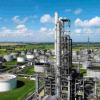Alok:
Thanks for your reply and explanations. I perceive that you may be in charge of the syn gas and Hydrogen production unit of an ammonia + urea complex and that your acid gas removal system has been designed (and possibly erected) by BASF using their novel αMDEA process. Please confirm if that is the case. I feel more comfortable knowing exactly what the circumstances are in a problem.
If, indeed, BASF has furnished the CO2 removal process design (& erection?) independently or through the main engineering contractor, then there has to be a complete P&ID as well as a PFD with complete heat and mass balance of the unit. These documents should be part of the BASF license to operate the facility efficiently and in the prescribed manner. As the operator of the unit, you must have total access to these documents in order to determine if you are operating the unit as prescribed and, if so, what are the results with respect to the specifications for the process. The heat and mass balance is normally given in a tabular fashion, citing all the process (and utility) streams. Therefore, the Heat and Mass Balance should state the enthalpy of the process gas entering and leaving the MDEA reboiler. It should be that simple. If you have not been supplied with the complete unit documentation, then you have a problem because you can’t comply with the conditions BASF has specified for your process.
BASF has developed a clever and novel manner of applying the MDEA process for CO2 removal. Instead of relying on pure waste steam for reboiler use, they simply take the Shift Converter outlet stream and use that heat content to reboil (while also injecting steam and condensate prior to the reboiler because the original heat content is not enough). However, I note in the Process Description that the Stripper overheads is at only 91 oC. I am used to furnishing sufficient heat in the reboiler tube bundle to make the overheads 104 oC - well above the boiling point of water. The description states that the stream is “saturated” with water vapor. However, it is wise to always furnish an excess of steam vapor in the overheads to ensure that the amine is thoroughly depleted of the design CO2 loading, making the lean solution as strong as possible in MDEA and making sure that as much CO2 is removed in the absorber as possible with the given MDEA flow rate and temperature conditions.
Besides, doesn't the 91 oC temperature for the saturated CO2 mean that the Stripper top is at 0.75 kg/cm2A - a partial vacuum?
All steam reformers in syn gas plants have the ability to generate low pressure steam for process use. However, your gas analysis indicates that atmospheric air may be introduced in the upstream syn gas preparation - possibly in an oxidation process (like the old Texaco process?) to produce the hydrogen and nitrogen. In this case, BASF may have opted to use the hot process gas directly in the MDEA reboilers. But this integrated process heat use introduces trade offs that I have mentioned before. The reboilers have to be thermosyphon design (with little or no turn down), the amount of reboil heat is limited to the process gas, the size and shell thickness of the reboilers has to be increased because the heat transfer is almost all latent heat (as would be expected) - so the sensible heat contributed is negligible. The process gas piping remains relatively large and the cost for so complex a run is more while the complexity and balance of the system - especially at startup is more taxing. I particularly do not like the low 91 oC at the top of the CO2 strippper and wonder how efficient operation can be done to produce a lean MDEA with low CO2 loadings (expressed in mole CO2/Mole MDEA).
I don’t know with what intention the reboiler duty has been identified as 15.7 Gcal/hr. Is this value from the Heat and Mass Balance? Or is it from some other document? As I show in the workbook furnished, the sensible heat contribution is negligible - as would be expected (are you sure the stream enthalpy is correct?). It is the latent heat of the steam content in the Process Gas that is doing most or all of the heat transfer. Because the reboiler has to handle all the rest of the process gas, it has to be a bulky and rugged design that is expensive to build and install. The process syn gas, in my opinion is merely acting as an inert vehicle for the steam injected into it further upstream. As in any other process, it is very expensive to extract the heat from gases because of the very poor heat transfer coefficients involved. The required heat exchanger turns out to be relatively much larger than a comparable steam-heated device.
I am pleased to see that BASF has applied what I already knew and used 55 years ago: you don’t have to employ a so-called “reflux” to an amine stripper to produce adequate lean amine and efficient CO2 removal.
My workbook is not pass word-protected; you can easily un-protect it with a click. Thank you for the macro explanation.

 FB
FB













